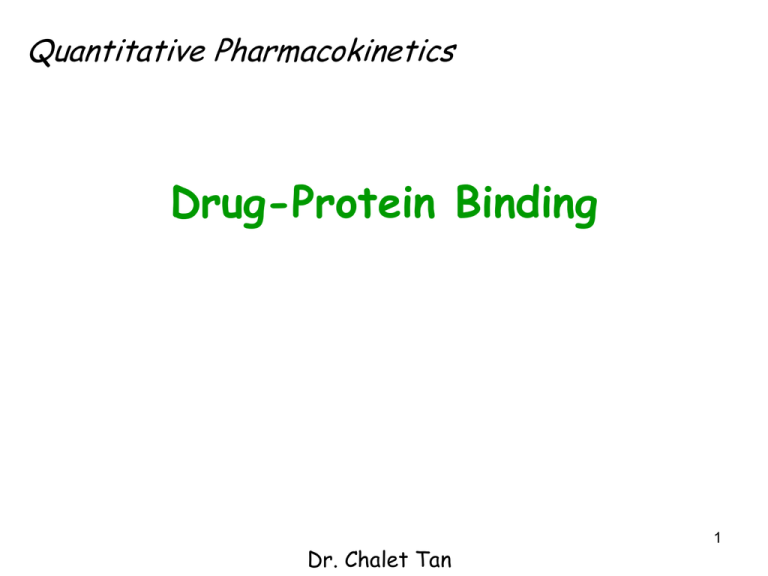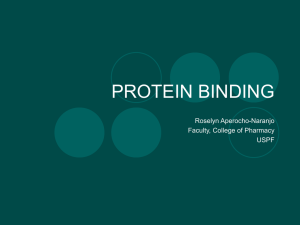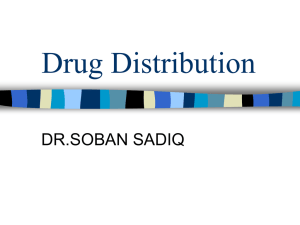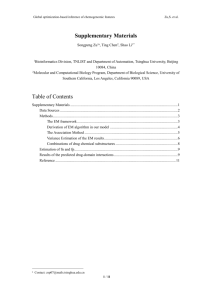Drug-Protein Binding
advertisement

Quantitative Pharmacokinetics Drug-Protein Binding Dr. Chalet Tan 1 Learning Objectives proteins that bind drugs and types of protein binding factors affecting drug-protein binding effect of protein binding on drug distribution Required reading: Tozer & Rowland, Introduction to Pharmacokinetics and Pharmacodynamics, Chapter 5, p83-89. 2 Relevance of Drug-Protein Binding to Drug Therapy protein-bound drugs are pharmacologically inactive protein-bound drugs does not cross cell membranes, affecting: distribution metabolism excretion 3 Types of Drug-Protein Binding reversible • weak chemical bonds such as hydrogen bonds or van der Waals forces • occurs to most drugs irreversible • covalent chemical bonds • accounts for certain toxicities of drugs and carcinogens e. g. high doses of acetaminophen 4 Major Drug-Binding Proteins in Plasma TABLE 5-3 albumin: binds mostly to acidic drugs a1-acid glycoprotein: binds mostly to basic drugs lipoproteins: binds mostly to neutral drugs 5 The fraction of unbound drug in plasma varies widely among drugs 0 ≤ fu ≤ 1 Figure 5-13 6 Methods for Studying Drug-Protein Binding equilibrium dialysis ultracentrifuge gel chromatography electrophoresis For the ease of chemical analysis, total plasma concentrations of drugs (instead of unbound drug concentrations) are most commonly measured. 7 Drug-Protein Binding Affects Drug Distribution Figure 5-14 8 Drug-Protein Binding Affects Drug Distribution at equilibrium, Cu = CuT 9 Drug-Protein Binding Affects Drug Distribution V: volume of distribution Vp: volume of the plasma VT: volume of the tissue fu : free fraction of the drug in the plasma fuT : free fraction of the drug in the tissue VT of a drug is dependent on its physicochemical properties. 10 V and Volumes of Body Water For a 70-kg healthy individual, extracellular plasma 3L interstitial fluids 13 L intracellular 26 L Total 42 L V rarely correlates to a real volume. V of drugs with MW > 70 KD is close to 3 L. V of small MW drugs that are neither bound in plasma nor 11 in tissue is between 16 – 42 L. Factors Affecting Drug-Protein Binding drug • physicochemical properties • concentration protein • physicochemical properties • concentration displacement by co-administered drugs e. g. increased free warfarin level when co-administered with salicylic acid (displacer) 12 Displacement may occur if: the drug (e. g. warfarin) is highly protein-bound; and the displacer (e. g. salicylic acid) occupies most of the binding site. Factors Affecting Drug-Protein Binding pathophysiological conditions of the patients 14 V of propranolol is proportional to its fu in plasma. control patients with chronic hepatic disease Figure 5-15 15 Plasma Protein Binding Determines the Distribution of Many Drugs 16 V of Some Drugs Does Not Depend on Plasma Protein Binding 17 Furosemide and amiodarone have fu between 0.02-0.04, an acidic and a basic drug respectively. Yet, the former has a V of 10 L and the latter 7000 L. What contributes to this difference? 18




![PHT414 [ Lec. 4] Drug distribution Alteration of drug distribution and](http://s3.studylib.net/store/data/007354790_1-f154f11cc33ccc757a4c59622936a98b-300x300.png)



